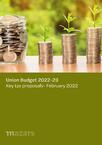Union Budget 2022-23 I Key tax proposals
Finance Minister, Smt. Nirmala Sitharaman, presented the fourth budget under the Modi 2.0 government, with a focus toward fostering economic and financial inclusion amid a sustainable and tech-driven ecosystem. The budget was accordingly built around four key priorities, namely:
- PM Gatishakti
- Inclusive development
- Productivity Enhancement & Investment, Sunrise Opportunities, Energy Transition, and Climate Action
- Financing of Investments
PM GatiShakti is a game-changing strategy for economic growth, with its seven engines propelling together to fuel development. This is envisioned to run on a seamlessly connected multimodal and logistically efficient network, which highlights that infrastructural focus is here to stay and grow.
Projects include, among others, bringing 2,000 km of railway network under Kavach, lining up 400 new-generation Vande Bharat Trains on the developmental pipeline, or expanding 25,000 km of roadway under the National Highways network. The specific focus given to hilly areas, which otherwise cannot be integrated by conventional roads, is a welcomed move to not only boost commuting ease but also encourage tourism.
The role of technology has been brought to the forefront, with the Unified Logistics Interface Platform (ULIP) one of the many initiatives to power both mobility, as well as real-time and transparent information exchange across the network.
As a matter of fact, technology – or more specifically digitization – has been of prime importance in all priorities this year. Whether it be re-designing education delivery modes amid covid restrictions, streamlining agricultural processes, powering public-sector research, or engineering payment gateways, the use of various e-platforms is very much in play. The government has expressed a key interest for optimizing upon accelerators like artificial intelligence, blockchain and machine learning to foster growth in many areas. The RBI’s introduction of the digital rupee through blockchain technology this year will be a key highlight in this regard.
The budget has been a huge push for the drone industry, with start-ups being promoted to facilitate Drone Shakti, with 'drone as a service'. The use of Drone Shakti and Kisaan Drones are pivotal steps that will disseminate this technology to people at the grassroots level.
An open platform for the National Digital Health Ecosystem will further facilitate digital health access and operations, which has proved to be critical in the last two years.
The government also wants to make it easier to bank online. It plans to achieve so by establishing 75 digital banking units across 75 districts by Scheduled Commercial Banks. This will encourage more people to use digital wallets.
The focus on MSMEs is also important this year. According to IBEF, India has roughly 6.3 crore MSMEs that contribute around 30% of the country’s GDP through national and international commerce. More than 130 lakh MSMEs have benefited from the Emergency Credit Line Guarantee Scheme (ECLGS), which has provided them the much-needed extra credit. With necessary finances, the Credit Guarantee Trust for Micro and Small Enterprises (CGTMSE) scheme will be rebuilt. This will allow Micro and Small Enterprises to access additional financing worth INR 2 lakh crore, resulting in more job opportunities.
Another highlight this year has been on Sustainability and the drive to take on “greener” and holistic economy development. Among the many climate-change driven initiatives, the uptake of sovereign green bonds showcases the intent toward impact investing which can help India emerge as a global leader on many parameters.
While no modifications to tax slabs were made, specific direct and indirect tax policies were proposed to stimulate "voice for local" and progress toward Atmanirbhar Bharat. Further, the government recommended a 30% tax on revenue received from cryptocurrencies and other virtual assets, clarifying taxation of these assets.
Procedural and administrative refinements continue as the goal toward a “Trust-based governance” system becomes mainstream, driving ease of living and doing business across the country. The move toward allowing taxpayers to declare omissions and errors themselves for prior filings showcases that voluntary compliance will ensure better compliance in the coming time.
Capital expenditure has jumped by 35.4% to reach 7.50 lakh crore in FY23, standing at 2.9% of GDP. The revised fiscal deficit in the current year is estimated at 6.9%of GDP, as against 6.8% projected in estimates. Fiscal deficit for this year is pegged at 6.4% of GDP, which is in line with the target to reach a deficit below 4.5% by 2025-26, without compromising on growth objectives.
On a wider front, the budget this year has been quite visionary and holistic, where the focus was not upon announcing a host of new goals but rather defining the action plan to attain long-sought objectives. This blueprint can become a driving ground that will ensure the completion of various milestones ahead.


